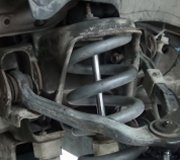First stop at another shop and have the steering and suspension systems inspected. They should give you a written list of anything they find needs to be repaired.
The next thing is they should have provided a copy of the alignment printout. All alignment computers today have that capability but not all shops use it. Those show the specs, the "before" readings from before any changes were made, and the "after" readings that show what the mechanic set the adjustable angles to. The three main angles are "caster", camber", and "toe". Caster is not critical on front-wheel-drive vehicles, and it's not adjustable on most of them, but camber is the most important one when dealing with a pull. It's important camber be in specs to reduce tire wear, but it's critical it be nearly even on both sides to prevent a pull.
If camber is okay, (it should be perhaps as much as.08 degrees higher on the left to compensate for road crown - roads tilting to the right so water runs off), you also have to consider a tire pull. That is not terribly uncommon with new tires. There's two ways to identify that. When a front-wheel-drive car pulls to the left during acceleration, it will pull to the right during hard braking. If you observe that, the second clue is it will pull to the right on acceleration, or go straight, after switching the two front tires side to side.
This is not really a defect in either tire. They simply have significantly different rolling resistance. If the car goes straight after switching the tires, just leave them there until they wear out. If they pull the other way, switch them to the rear where they won't cause a problem.
SPONSORED LINKS
Saturday, August 8th, 2015 AT 10:46 PM



